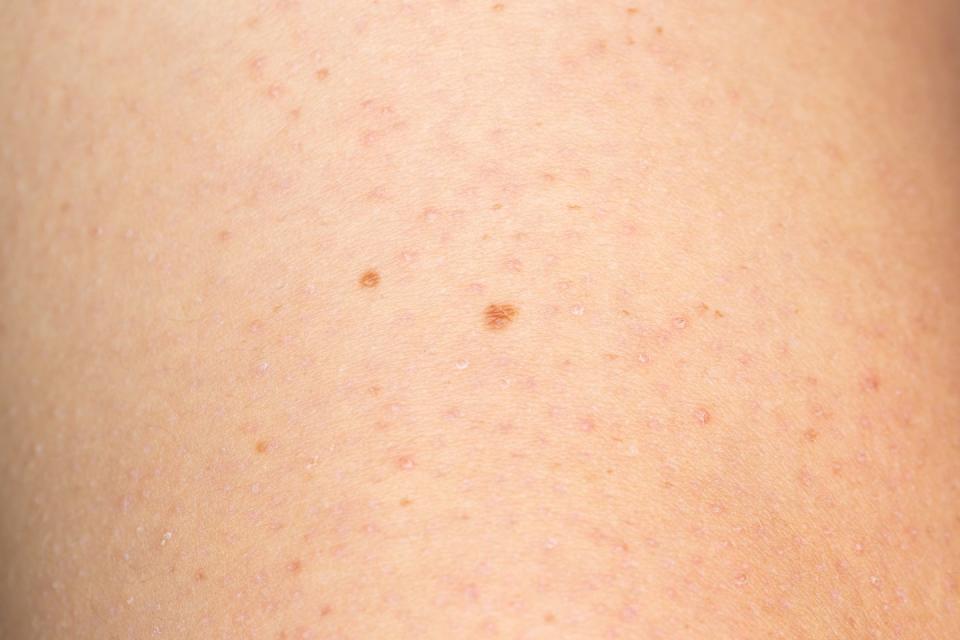How to Get Rid of Keratosis Pilaris Arm Bumps For Good

Have you ever touched the back of your arms and felt a rough texture, or noticed red bumps on your skin? Chances are it's keratosis pilaris (KP), colloquially known as "chicken skin." But don't be intimidated by the scientific-sounding name — this is one skin condition that's totally harmless.
Essentially, KP is caused by buildup of dead skin cells that are mildly inflamed. "Keratosis pilaris are small, firm, sometimes red bumps that commonly occur on the back of the arms, legs, and sometimes buttocks and can resemble pimples," explains Joshua Zeichner, M.D., a dermatologist in New York City.
On the bright side, these bumps aren't an indicator of a serious skin issue like eczema (which involves your skin being inflamed and itchy) or psoriasis (where your immune system attacks your skin, causing red scaly patches). "Even people who are completely healthy can get these bumps," Dr. Zeichner explains. "They're more of a cosmetic issue than anything."
How long does keratosis pilaris last?

Unfortunately, there is no permanent cure for keratosis pilaris: It is a chronic condition that usually won't go away with a single treatment. "KP tends to flare with weather shifts, so from summer to fall and winter to spring," explains Rita Linkner, M.D., a dermatologist at Spring Street Dermatology in NYC.
While many skin conditions are impacted by diet, keratosis pilaris isn't believed to be one of them. "There is no clear association between diet and the worsening of keratosis pilaris," Dr. Zeichner says. "However, sugary foods and dairy are generally thought to promote inflammation in the body, so keep that in mind when selecting your snacks."
What is the best keratosis pilaris treatment?
There are a few things you can do to keep KP at bay:
Prescription retinoids. "In the office, we can prescribe topical retinoids that normalize the growth of skin cells and help prevent dead ones from accumulating in the pores," Dr. Zeichner says.
Resurfacing laser treatments. You can also try a laser treatment to improve the appearance of redness, which often occurs around individual bumps. "Resurfacing lasers may give modest benefits by strengthening the foundation of the skin," Dr. Zeichner explains, but lasers will not change your genes or prevent cells from sticking together and blocking the pores in the future.
A curated skincare regimen. "It can take a few weeks to improve with the properly curated skincare routine," says Dr. Linkner. In order to keep your arms bump-free, you need to be diligent about exfoliation and hydration.
How can I get rid of keratosis pilaris at home?
Dr. Zeichner recommends treating the area with hydrating and exfoliating ingredients, like lactic acid or salicylic acid, to help remove dead skin cells for a smoother texture. Urea is another ingredient that softens rough skin and helps hydrate at the same time. Dr. Linkner also suggests glycolic acid, retinol, and vitamin C used in tandem with proper moisturizers. Just remember to avoid over-exfoliating, which can lead to irritation and worsen KP.
And no matter how much you may be tempted, avoid picking at the bumps, which can lead to inflammation, scabbing, and marks or scars that are more prominent than the keratosis pilaris itself. Here are the best products to treat keratosis pilaris at home, according to dermatologists:
1. Best Lotion for Keratosis Pilaris
This Vaseline formula's "cocoa and shea butters are excellent emollients to help soften the rough cells on the surface of skin and minimize the appearance of keratosis pilaris," Dr. Zeichner says. "The light lotion is easy to spread over large body surface areas."
2. Best Keratosis Pilaris Treatment for Arms
Another favorite of Dr. Zeichner's, this AmLaction lotion "contains lactic acid, a gentle alpha hydroxy acid that helps remove rough cells from the skin and within the follicles," he explains.
3. Best Keratosis Pilaris Treatment for Face
Inn Beauty Project's exfoliating toner can be used daily without irritating the skin and improves the appearance of the facial bumps seen in keratosis pilaris. "The blend of six different hydroxy acids work together to give an incredible exfoliating benefit," Dr. Zeichner says.
4. Best Keratosis Pilaris Treatment with Urea
Dr. Zeichner is a big fan of this multi-tasking Aveeno oil, which contains urea, a moisturizing ingredient that helps the skin shed dead cells, and soothing oat extract to soften and hydrate skin.
5. Best Exfoliator for Keratosis Pilaris
Dr. Linkner stresses the importance of both exfoliating and hydrating skin when treating KP. She loves that this Rodan + Fields face scrub includes vitamin C, which can make for an even stronger improvement in the tactile feel of the keratosis pilaris bumps.
6. Best Body Wash for Keratosis Pilaris
This popular Dove body wash uses ultra gentle manual exfoliators to remove dead cells from the surface of skin. "It contains the same types of ingredients found in traditional moisturizers, so it hydrates while it exfoliates and cleanses," Dr. Zeichner says.
7. Best Face Wash for Keratosis Pilaris
Good news: you can use the same type of facial cleansers to minimize the appearance of pores and to treat keratosis pilaris, like this one from Neutrogena. "I love that this cleanser contains glycolic and salicylic acids to remove excess oil and dead cells from the skin and can be used both on your face and body," Dr. Zeichner says.
8. Best Balm for Keratosis Pilaris
Dr. Linkner recommends using this Vaseline jelly stick, a GH Beauty Award winner, for hard-to-reach areas where keratosis pilaris originates like the outer thighs and buttocks. "This is great for those who flare as it utilizes Vaseline's hydration powers in helping to nourish the skin during breakouts," she says.
You Might Also Like

 Yahoo News
Yahoo News 
